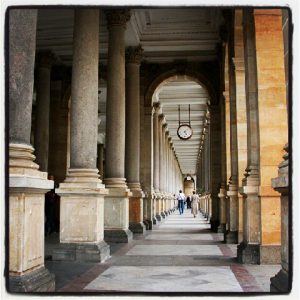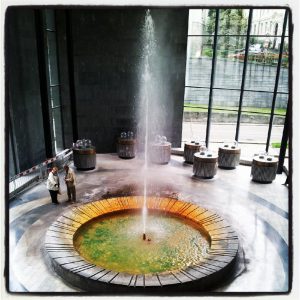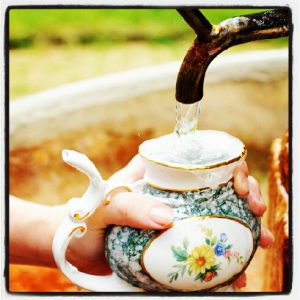The Colonnades of Karlovy Vary (Karlsbad/Carlsbad)
By Tracy A. Burns
 The popular west Bohemia spa town is often pictured with its elegant colonnades. Each of Karlovy Vary’s five colonnades has a unique character flaunting various architectural styles and an intriguing history. In a sense, these promenade halls have come to symbolize this city, famous for its curative hot springs and founded by Holy Roman Emperor and Bohemian King Charles IV in 1370. A magnet for famous personalities including Russian Czar Peter the Great and composer Ludwig van Beethoven, Karlovy Vary is today also known as the home of the Czech liqueur Becherovka and the glass manufacturer Moser.
The popular west Bohemia spa town is often pictured with its elegant colonnades. Each of Karlovy Vary’s five colonnades has a unique character flaunting various architectural styles and an intriguing history. In a sense, these promenade halls have come to symbolize this city, famous for its curative hot springs and founded by Holy Roman Emperor and Bohemian King Charles IV in 1370. A magnet for famous personalities including Russian Czar Peter the Great and composer Ludwig van Beethoven, Karlovy Vary is today also known as the home of the Czech liqueur Becherovka and the glass manufacturer Moser.
Mill Colonnade (Mlynska kolonada)
Perhaps the most popular hall is the Mill Colonnade, the largest of the five structures, measuring 132 meters long by 13 meters wide and featuring 124 Corinthian columns perched on its roof. It harkens back to the late 18th century when it was just a wooden building. Then, in 1811, the simple structure was transformed into an Empire-style edifice called the New Spring Colonnade. It drew large crowds; spa guests flocked to it. Now the Mill Colonnade, a pseudo-Renaissance style hall, stands on this site with its nave and two aisles. It was constructed by well-renowned Czech architect Josef Zitek from 1871 to 1881. Zitek is famous for his designs of Prague’s National Theatre and Rudolfinum. About 10 years after the construction was completed, an extension was built, leading to the Rock Spring. In addition to the majestic columns, the colonnade’s elaborate, spellbinding decoration includes 12 allegorical statues, each standing for a month of the year, situated above the portico, and stone reliefs depicting historic events in the town’s history decorating the orchestra pit. Ironically, Zitek’s creation triggered much negative criticism when it was built. People often compared the colonnade to a bowling alley. Today the reception is quite different. The Mill Colonnade houses the seeps of five thermal springs.
Park Colonnade (Sadova kolonada)
This wrought-iron architectural gem is all that remains of the Blanensky Pavilion where a concert and restaurant hall used to be located. The Blanensky Pavilion was designed by Viennese architects Ferdinand Fellner and Hermann Helmer during 1880-81. Better known for their theatre creations, Fellner and Helmer designed structures throughout the town, including the luxurious Grandhotel Pupp. Set in romantic Dvorak Park near the Army Spa Institution, the Park Colonnade was reconstructed in 2001 and 2002, when it obtained the Snake Spring. The Park Spring dates back to the middle of the 19th century.
The Hot Spring Colonnade (Vridelna kolonada)
 Housing the biggest and hottest spring, this colonnade has taken on many guises. It was built as Baroque during the late 18th century and then was rebuilt in Empire style to the design of Josef Esch in 1826. During 1878 and 1879 Fellner and Helmer did their magic and turned it into a pseudo-Renaissance structure. It became dilapidated in the 20th century, and the Nazis took it apart in 1939 to use the copper on its roof for making armaments. It was changed into a wooden promenade hall until 1975 when Jaroslav Otruba gave it a functionalist facelift. The Hot Spring Colonnade is made of glass and reinforced concrete. The Hot Spring (Vridlo), located in a separate pavilion, belches out 2,000 liters of mineral water per minute, rising to an impressive height of 12 meters. A glass prism-shaped dome covers this spring, the only one used for bathing and drinking. There are five more seeps as well.
Housing the biggest and hottest spring, this colonnade has taken on many guises. It was built as Baroque during the late 18th century and then was rebuilt in Empire style to the design of Josef Esch in 1826. During 1878 and 1879 Fellner and Helmer did their magic and turned it into a pseudo-Renaissance structure. It became dilapidated in the 20th century, and the Nazis took it apart in 1939 to use the copper on its roof for making armaments. It was changed into a wooden promenade hall until 1975 when Jaroslav Otruba gave it a functionalist facelift. The Hot Spring Colonnade is made of glass and reinforced concrete. The Hot Spring (Vridlo), located in a separate pavilion, belches out 2,000 liters of mineral water per minute, rising to an impressive height of 12 meters. A glass prism-shaped dome covers this spring, the only one used for bathing and drinking. There are five more seeps as well.
The Chateau (or Castle) Colonnade (Zamecka kolonada)
A tower is all that remains of a Gothic castle built by Holy Roman Emperor Charles IV on this site. An arbor was built over the Chateau (Castle) Spring in the late 18th century, and in 1830 architect Josef Esch constructed a hall made of wood. Viennese architect Johann Friedrich Ohmann gave it an Art Nouveau makeover from 1910 to 1912. A stunning Art Nouveau relief decorates the Lower Chateau (Castle) Spring. Showing the ghost of the springs, it was created by Viennese sculptor Wenzel Hejda in 1913. The colonnade features two parts – the Upper Spring Colonnade, open to the public, and the Lower Spring Colonnade, which only guests of the Castle Spa and Wellness Center can use.
 The Market Colonnade (Trzni kolonada)
The Market Colonnade (Trzni kolonada)
The white elegance of the Market Colonnade is the 1883 exquisite work of Fellner and Helmer. It started off as a wooden Swiss-style structure. Now it still has a Swiss appearance with delicate lace motifs on its façade, giving it a light and airy look. It is also notable for its gabled roof, majestic columned arcade decorated with wood carvings, and relief depicting the legend of the founding of the town. The Market Spring goes back to 1838 while the spring named after Emperor Charles IV is said to be the one that persuaded the Czech ruler to create the spa.




